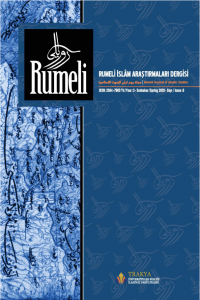Öz
Süsleme sanatı ile ilgili özellikle İran İslam sanatının altın çağı olarak anılan Büyük Selçuklu dönemine ait araştırmalarda, İran'ın en zengin alçı kitâbe ve süslemelerinin örneklerini içeren Kazvin Mescid-i Haydariye'nin bu önemli alçı süsleme ve kitabeleri hakkında bilgilerin yok denecek kadar az olması, oldukça üzücüdür. Buradan hareketle “Kazvin Mescid-i Haydariye'nin Büyük Selçuklu Alçı Süsleme ve Kitabeleri” başlığıyla hazırlanmış olan bu makalenin amacı, Kazvin Mescid-i Haydariye'nin alçı süsleme ve kitabelerini tanıtarak yapının mühim ve henüz açığa çıkmamış değerlerini ortaya koymak, böylece etkilenme alanı ile etkileme gücünü değerlendirme fırsatı sunmaktır. Ele alınan Kazvin Mescid-i Haydariye'nin alçı süslemelerinin çoğu örnekleri, zamanla harap olmuştur. Araştırmamız neticesinde, söz konusu yapının süsleme kompozisyonunun, yazı, bitkisel ve hendesî bezemeler içerdiği; bunun yanı sıra kabartma, kazıma ve kalıplama tekniğinde yapıldığı fark edilmiştir. Bezeme kompozisyonları, mihrap, duvar yüzeyleri, tuğla derzleri ve nişlerde yer almaktadır. Yapıya ait alçı süslemelerin sanatçısı ile ilgili malumat bulunmamakla birlikte caminin süsleme ve kitabelerinin yapılış tarihi konusunda farklı yorumlar söz konusudur. Yapının iç mekân beden duvarları üzerindeki kûfî hatlı kitâbenin içeriği incelenerek Sultan Gıyaseddin Ebu Şuca' Muhammed b. Melikşah zamanında, dönemin Kazvin valisi olan Emîr Humârtâş b. Abdullah-i İmâdî tarafından yaptırıldığı tespit edilmiştir. Bu yapıda görülen alçı süslemeler; İran'ın Sasani dönemine (226-651) ait alçı süslemeleri, Nîşâbur’da yapılan kazı çalışmalarından çıkan İran'ın ilk İslâm dönemine (X. yüzyıl) ait süslemeler, Abbâsîler Dönemi (Sâmarrâ Şehri / 836-892), Karahanlı (840-1212), Gazneli (963-1186), Anadolu Selçuklu (1075-1308) ve İran'ın İlhanlı dönemi (1256-1353) alçı süslemeleri ile büyük ölçüde benzerlik arz etmektedir.
Anahtar Kelimeler
Alçı Süsleme Büyük Selçuklu Kazvin Mescid-i Haydariye Mimari Cami İran Kitabe
Destekleyen Kurum
Ondokuz Mayıs Üniversitesi BAP Birimi
Proje Numarası
PYO.ILH.1904.18.001
Kaynakça
- Altun, Ara, “Karahanlılar, Mimari”, DİA, 24: 412, İstanbul: Türkiye Diyanet Vakfı Yayınları 2001.
- İbnü'l-Cevzi, Ebü'l-Ferec Abdurrahman, el-Muntazam fi Tarihi'l-Muluk ve'l Ümem. Beyrut, 1995.
- Khazaie, Mohammad, Hamidi, Bahram, “Moerrifi ve Berresi Tezyinat-i Geçbori Mescid-i Haydariye-i Kazvin”, Kitab-i Mah-i Huner, S. 155, Tahran 1390 h.ş.
- Öney, Gönül, “İran'da Erken İslam Devri Alçı İşçiliğinin Anadolu Selçuklu Sanatında Akisleri”, Belleten 37 (1973): 257-277.
- Râfiî, Abdülkerîm b. Muhammed, et-Tedvîn fî ahbâri Kazvîn. Beyrut, 1987.
- “Kazvin Mescid-i Haydariye Yazı Kuşağından Ayrıntı”, Confessions of a Bookplate Junkie, Son Erişim: 15 Nisan 2020, https://bookplatejunkie.blogspot.com.
- “Kur'an-ı Kerim Portalı”, Diyanet İşleri Başkanlığı Kur'an-ı Kerim Portalı, Son Erişim: 3 Temmuz 2020, https://kuran.diyanet.gov.tr/.
Öz
It is unfortunate that in most researches of Islamic decorative art, especially the research of the Great Seljuk period that was called the golden age of Iranian decorative arts has been little talked about of rich ornamental values of stucco decorations and inscriptions of the Heydarieh Mosque of Qazvin. According to this, one of the aims of this article, prepared with the title of the Great Seljuk Stucco Ornaments and Inscriptions of the Heydarieh Mosque of Qazvin, is to introduce the art of stucco decorations of the Heydarieh Mosque of Qazvin. Another aim of this article is to rediscover the exceptional value of the decorations of this mosque and understanding of the interaction scopes of the decoration of this mosque. Unfortunately, many of the stucco decorations of this mosque have been destroyed. According to the results, the stucco decorations in this mosques include inscriptions, vegetal and geometric decorations made using the embossing, engraving and stamping techniques. These decorations are generally located on the mihrab, the interior surfaces of the walls, the pointings between the bricks and the wall niches. Any source of information about the stucco decoration of the mosque is not available. Although there are different interpretations about the date of the decoration and the inscriptions of this mosque, based on the content of the kufi inscription on the interior surfaces of the wall of this mosque, it was found that these decorations and inscriptions are belong to the Amir Khomartash ibn Abdullah Emadi that who was Qazvin governor whose ruling coincides with the reign of Sultan Ghias-ud-Din Abu Shuja Muhammad ibn Malik-Shāh. Also according to the results of this research, the stucco decorations in this mosque, It is very similar to the decoration of the Sassanid period of Iran (61- 226), the decoration of the first Islamic era of Iran (around the tenth century AD), which were from Neyshabur excavations, stucco decorations discovered from Samarra Exploration (836-892), architectural ornaments of the Qarakhanid period (840-1212), stucco decorations from the Ghaznavid Period (1896-1996), Anatolian Seljuk Architectural decorations (1075-1308) and stucco decorations of the Ilkhanid Period of Iran (1256-1353).
Anahtar Kelimeler
Architecture Stucco Ornament Great Seljuk Mosque Iran Heydarieh Mosque of Qazvin Inscription
Proje Numarası
PYO.ILH.1904.18.001
Kaynakça
- Altun, Ara, “Karahanlılar, Mimari”, DİA, 24: 412, İstanbul: Türkiye Diyanet Vakfı Yayınları 2001.
- İbnü'l-Cevzi, Ebü'l-Ferec Abdurrahman, el-Muntazam fi Tarihi'l-Muluk ve'l Ümem. Beyrut, 1995.
- Khazaie, Mohammad, Hamidi, Bahram, “Moerrifi ve Berresi Tezyinat-i Geçbori Mescid-i Haydariye-i Kazvin”, Kitab-i Mah-i Huner, S. 155, Tahran 1390 h.ş.
- Öney, Gönül, “İran'da Erken İslam Devri Alçı İşçiliğinin Anadolu Selçuklu Sanatında Akisleri”, Belleten 37 (1973): 257-277.
- Râfiî, Abdülkerîm b. Muhammed, et-Tedvîn fî ahbâri Kazvîn. Beyrut, 1987.
- “Kazvin Mescid-i Haydariye Yazı Kuşağından Ayrıntı”, Confessions of a Bookplate Junkie, Son Erişim: 15 Nisan 2020, https://bookplatejunkie.blogspot.com.
- “Kur'an-ı Kerim Portalı”, Diyanet İşleri Başkanlığı Kur'an-ı Kerim Portalı, Son Erişim: 3 Temmuz 2020, https://kuran.diyanet.gov.tr/.
Ayrıntılar
| Birincil Dil | Türkçe |
|---|---|
| Konular | Din Araştırmaları |
| Bölüm | Araştırma Makaleleri |
| Yazarlar | |
| Proje Numarası | PYO.ILH.1904.18.001 |
| Yayımlanma Tarihi | 14 Ekim 2020 |
| Gönderilme Tarihi | 28 Ağustos 2020 |
| Yayımlandığı Sayı | Yıl 2020 Sayı: 6 |


